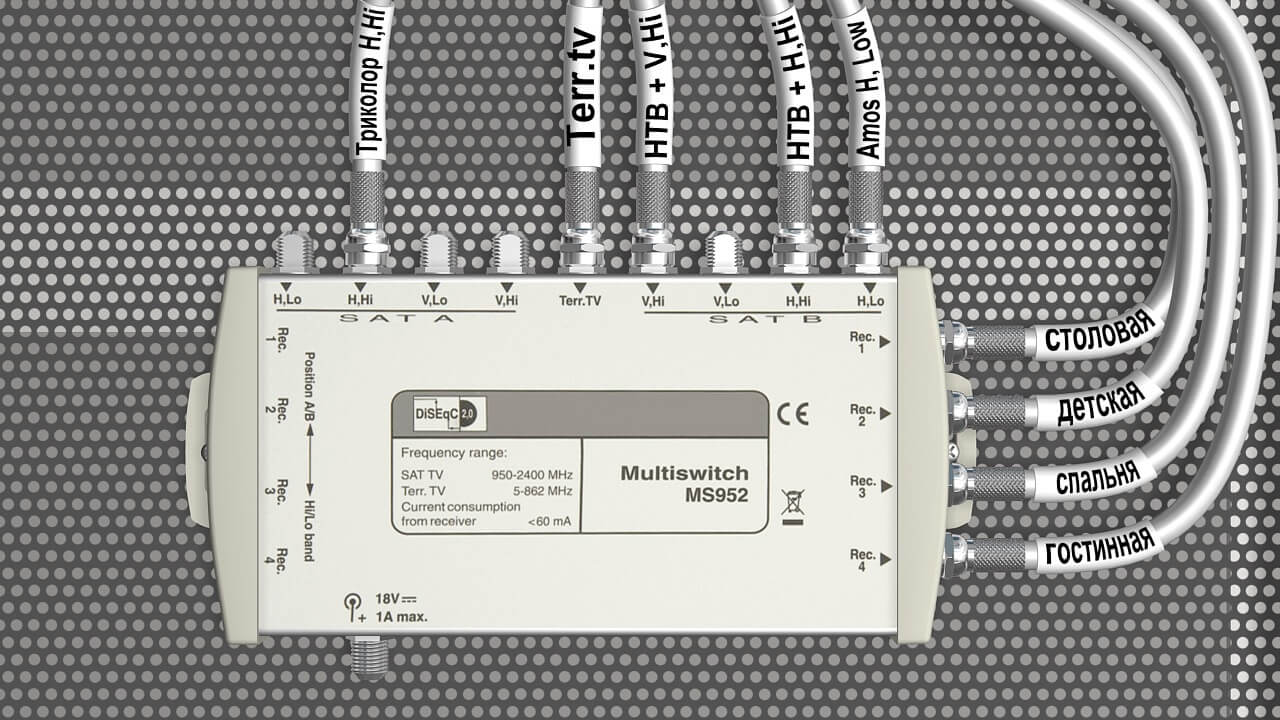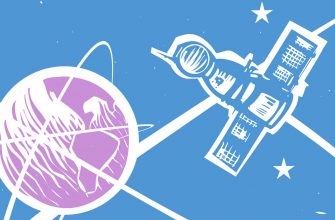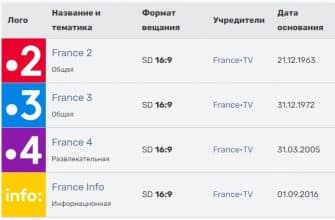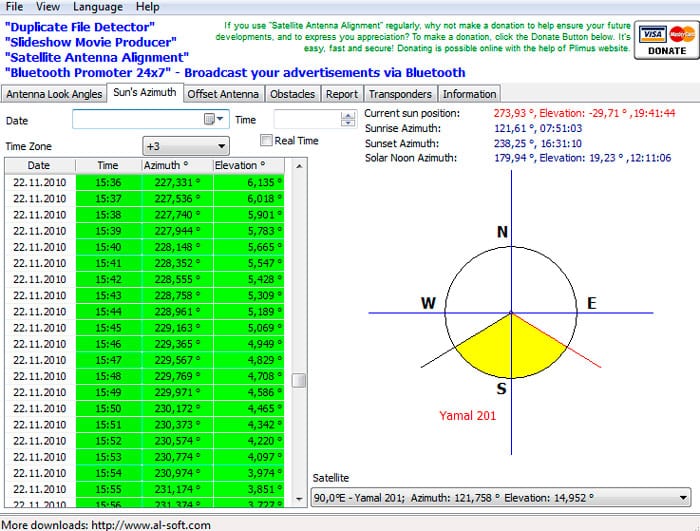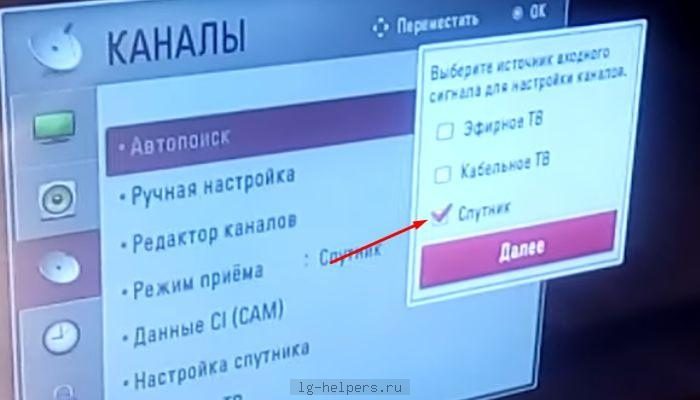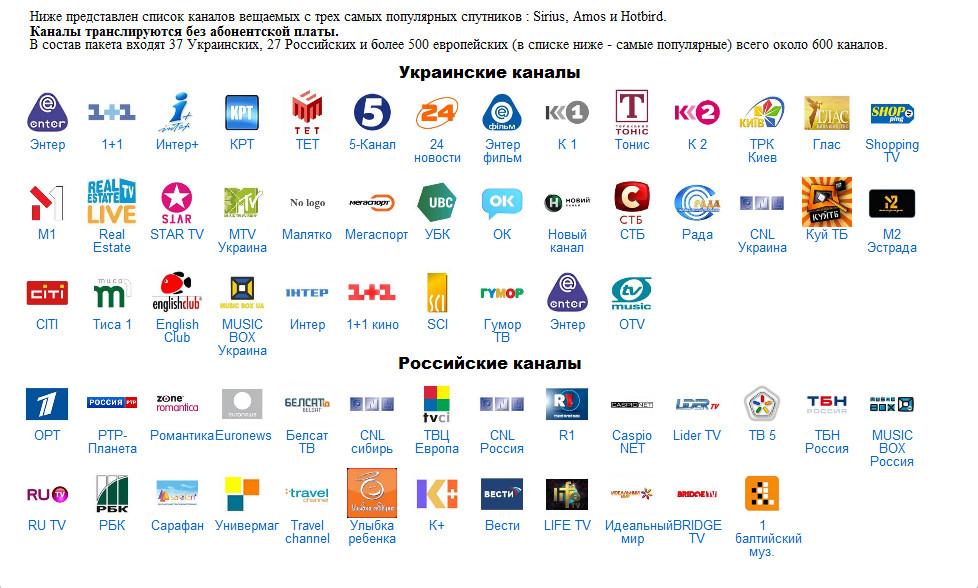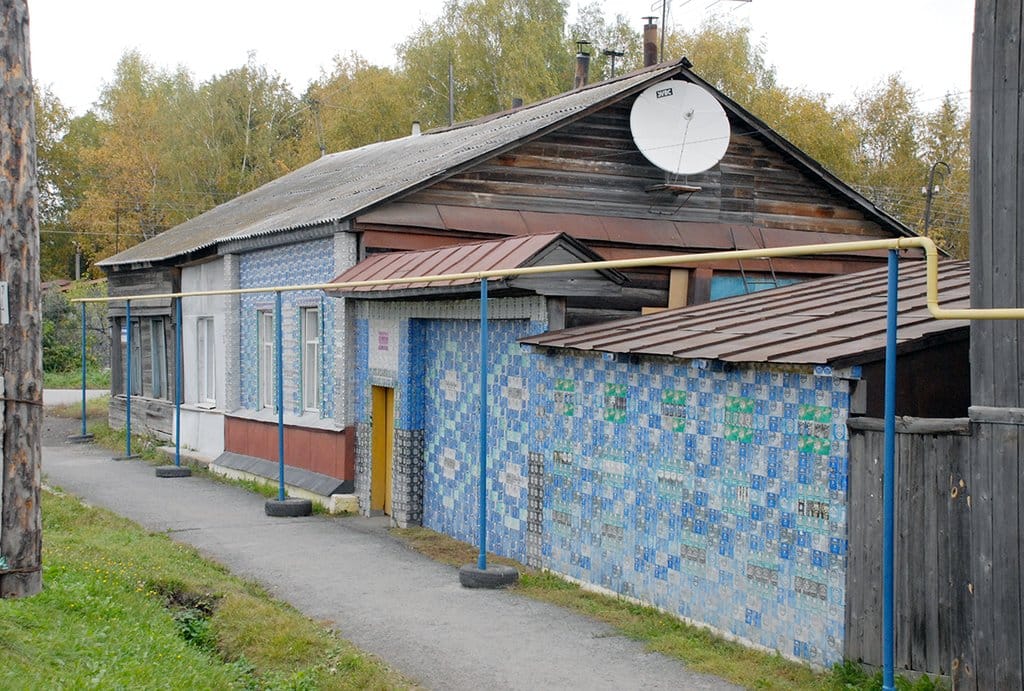The era of
satellite TV is gradually fading away, opening up new opportunities for Internet TV. However, not every point on the planet has the Internet in the open access now. To provide a large house with a satellite and terrestrial signal, a multiswitch is used. Let’s take a closer look at its device, why it is needed and how it is connected.
What is and why do you need a multiswitch for satellite dishes
The multiswitch acts as a kind of “equalizer” and “distributor” for the satellite and terrestrial signal. In fact, it is a small device that greatly simplifies the life of TV lovers.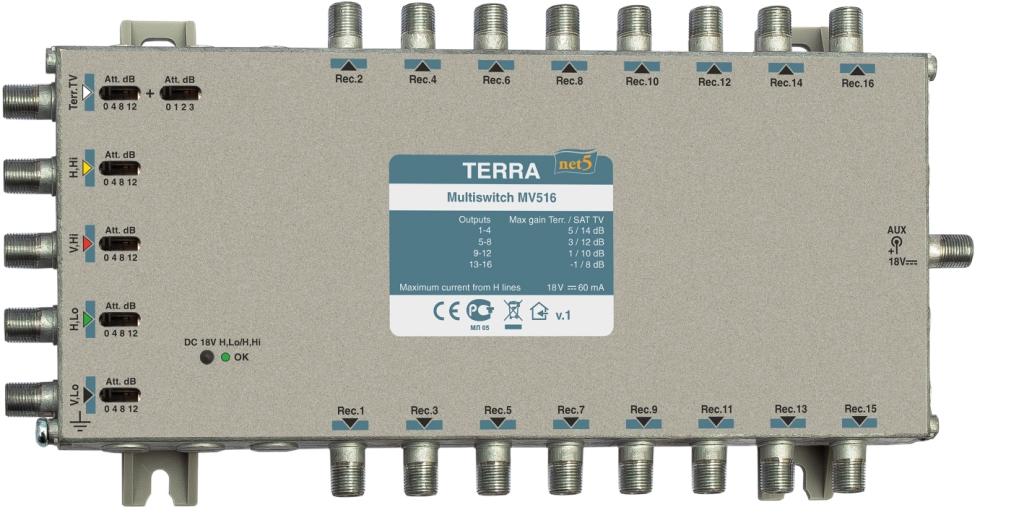 Multiswitch for satellite antennas [/ caption]
Multiswitch for satellite antennas [/ caption]
Why do you need
To understand why you need a multiswitch, you need to solve one riddle: how can you continuously provide your subscribers with satellite TV. At the time of the peak popularity of satellite television,
operators were faced with this serious question. The first and easiest option is obvious: one client = one
antenna/satellite. The formula is simple. However, along with a simple option, a simple problem arises: if there are 48 apartments in a house, and each apartment wants to host satellite TV, then there will be 48 antennas on the roof of the house that transmit data. This means that the roof will be completely covered by the transmitting devices. In some places it is inconvenient, and in some it is completely forbidden. The main inconvenience is a bunch of cables that are exposed to the external environment and can easily be stolen from the roof. The second option is to install a
satellite converterwith the number of outputs equal to the number of subscribers. However, here one should take into account not only all subscribers in the house, but also potential subscribers. It is also difficult to find a converter on the market that has more than 4 outputs.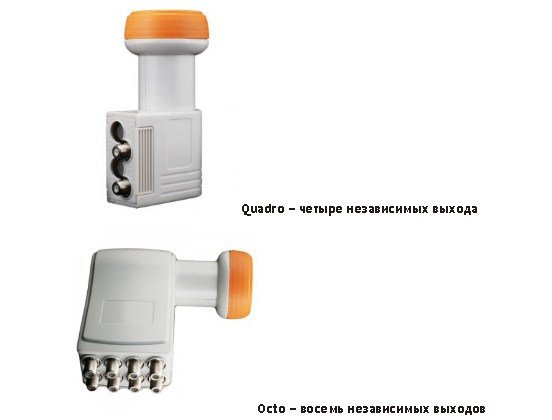 Satellite converter for 4 and 8 outputs [/ caption] The third option is to split the converter signal. For starters, forget that the RF signal level will drop with each division procedure. It is important that the divider is used only with the special support of the SAT PC, the range of which ranges from 950 to 2150 MHz, including the power pass. The SAT converter belongs to active devices, which itself understands the working area of the polarity. It is powered by the energy of the receiver or other source. In such a situation, a certain factor of subscriber dependence is formed. If some tenant of the house sends the maximum voltage towards the converter (18 Volts), then his neighbors, with a polarity different from it (for example, 12 Volts), will not be able to do this and will be left without a signal. Sometimes this neglect is acceptable.In such a situation, you can use an active divider of the satellite intermediate frequency signal. It differs slightly from the standard divider – the active one compensates for the decrease in the signal indicator at the moment when the signal passes through the cable. Also creates a great junction between exit paths. Operates at voltages from 12 to 18 volts. Power supply is possible only with a receiver with a supported frequency of 950 – 2400 MHz. All of the above options were implemented by representatives of satellite companies, but none of them was effective. In the course of the thought process, the Multiswitch was invented. The device was conceived as a universal solution in the “all functions in one box” format. However, this is applicable only for small programs – an over-the-air signal or a satellite signal.
Satellite converter for 4 and 8 outputs [/ caption] The third option is to split the converter signal. For starters, forget that the RF signal level will drop with each division procedure. It is important that the divider is used only with the special support of the SAT PC, the range of which ranges from 950 to 2150 MHz, including the power pass. The SAT converter belongs to active devices, which itself understands the working area of the polarity. It is powered by the energy of the receiver or other source. In such a situation, a certain factor of subscriber dependence is formed. If some tenant of the house sends the maximum voltage towards the converter (18 Volts), then his neighbors, with a polarity different from it (for example, 12 Volts), will not be able to do this and will be left without a signal. Sometimes this neglect is acceptable.In such a situation, you can use an active divider of the satellite intermediate frequency signal. It differs slightly from the standard divider – the active one compensates for the decrease in the signal indicator at the moment when the signal passes through the cable. Also creates a great junction between exit paths. Operates at voltages from 12 to 18 volts. Power supply is possible only with a receiver with a supported frequency of 950 – 2400 MHz. All of the above options were implemented by representatives of satellite companies, but none of them was effective. In the course of the thought process, the Multiswitch was invented. The device was conceived as a universal solution in the “all functions in one box” format. However, this is applicable only for small programs – an over-the-air signal or a satellite signal.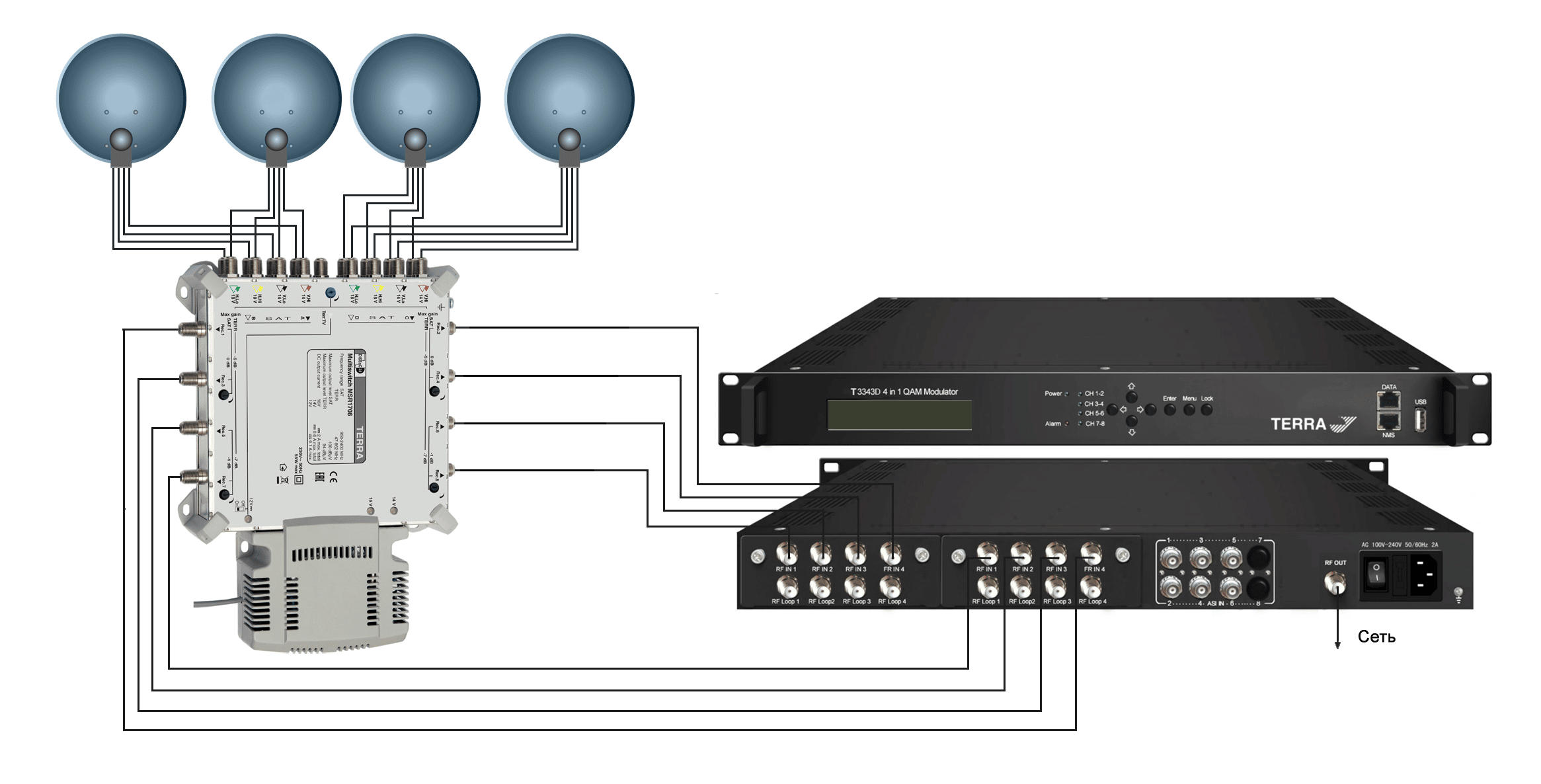 Multiswitch connection diagram [/ caption]
Multiswitch connection diagram [/ caption]
Multiswitch device
Multiswitch acts as a universal switch. It provides interaction of receivers with different outputs to the converter, or with different converters. The main task is to create all the necessary conditions for the receiver to work. If it falls to a flow of 13 Volts, then the multiswitch will simply transfer it to a port special for this power, for another flow – another port. Useful qualities of the device:
- It can be used to reject one polarity or one flow . Each connected subscriber will have all the parameters necessary for functioning. The receiver will be connected to the correct input, and accordingly, to a suitable converter. This applies to both entry and exit.
- The switch for TV also takes over the on- air part of the signal , in the range of 5-862 MHz. The entire stream goes to the subscriber through one cable, no excess of cords! Now you just need to install a diplexer on the consumer side – this will allow you to get two independent ports for satellite and TV.
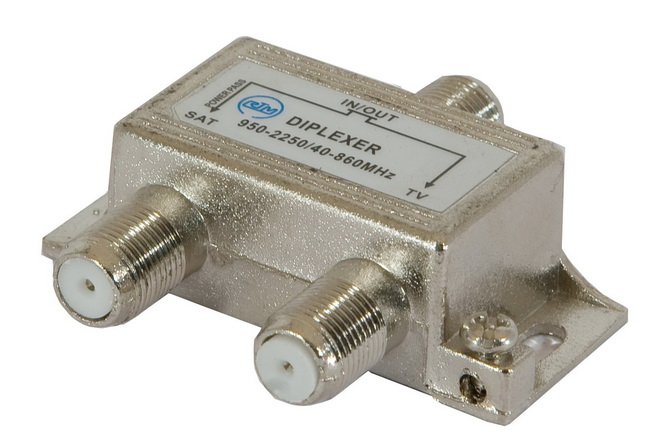 Diplexer and multiswitch in combination allow you to simultaneously receive satellite and cable TV signal [/ caption]
Diplexer and multiswitch in combination allow you to simultaneously receive satellite and cable TV signal [/ caption] - Frees the roofs and facades of residential buildings , ensuring signal reception for all residents.
How to choose what types of devices exist
When choosing, you should start from two factors: the number of points for connection and how far they are located from the antenna. According to the main characteristics, the multiswitch is divided into:
- Power supply: from 220 V and from 18 V.
- The number of input and output ports available.
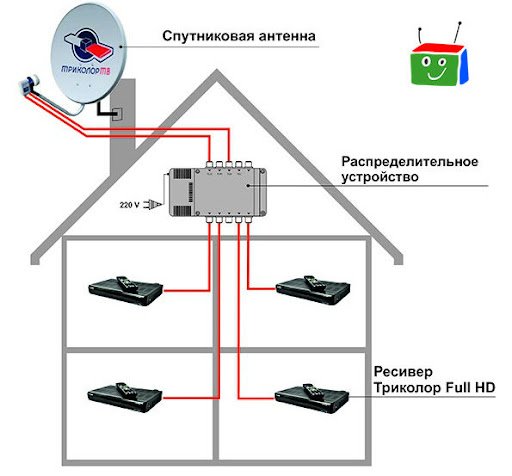 Multiswitch for a satellite dish for 4 TVs [/ caption] The number of points will allow you to understand how many outputs are needed to completely absorb the signal.
Multiswitch for a satellite dish for 4 TVs [/ caption] The number of points will allow you to understand how many outputs are needed to completely absorb the signal.
Cascaded or Terminal
The distance to the antenna directly affects the type of multiswitch required: cascaded or terminal.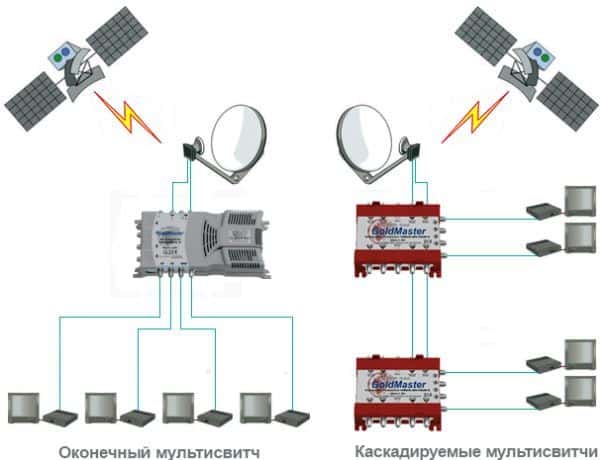 Cascading and terminal multiswitch [/ caption]
Cascading and terminal multiswitch [/ caption]
Cascading is widely used in apartment buildings, corporate offices and residential buildings with a large number of people. A device of this type does not need power and is added by a daisy chain at the signal routing point (often every floor in a building). It is important that the devices are connected to each other. If it is necessary to connect a signal amplifier, a power injector is connected, which requires an AC outlet with a power of 220 volts.
Terminalthe type of multiswitch is recommended to be installed in private houses or in small rooms. This is due to the close distance to the antenna. The device is connected to the switchboard, because it is into it that the cables from the antenna enter and from which the cables go to the receiver. The terminal multiswitch requires electricity. That is, within a radius of a meter, there must be a socket with an AC supply of 220 volts.
Active and passive multiswitches
There are also categories such as active and passive multiswitch models. The active model includes an integrated signal amplifier. This feature is necessary if you also need to connect an over-the-air antenna. To simplify the selection, some brands label their products as follows:
- P is passive.
- A – active.
- U – universal type.
This option is not provided for the passive category. For this, an additional external type amplifier is connected, which will have to be purchased separately. The passive and active multiswitch differ from each other in the parameters of the input signal: the passive one will give a lower value.
What is a multiswitch, purpose and application of the device:
https://youtu.be/cggC3FLtdaE
Connection and setup
The multiswitch is equipped with connectors for input (needed for
converters ), and output (for receivers). The number of output connectors is the same as the number of connected receivers. The number of receivers corresponds to the number of connected clients. Understanding how the output connectors work is a little more difficult. A Ku-band signal is fed into it, which is divided into types of polarization along with two sub-bands. This means, in order to receive the full spectrum of the stream from one transmitting device (in our case, a satellite), you will have to use 4 switch inputs, connecting to four converter outputs (in some cases, different converters).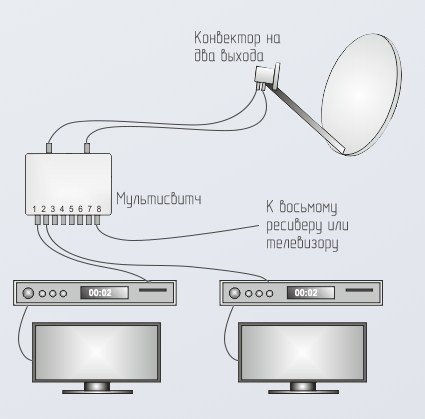 Wiring diagram of a multiswitch for a satellite dish with 8 outputs [/ caption] The signal of the C level range is not divided into sub-bands and is fed in one piece. Setting options:
Wiring diagram of a multiswitch for a satellite dish with 8 outputs [/ caption] The signal of the C level range is not divided into sub-bands and is fed in one piece. Setting options:
- If the multiswitch has from 1 to 4 input connectors for connection to the converter, the DiSEqC value must be turned off, or Disabled.
- If> 4 inputs, then DiSEqC is placed in position ½ or 2/2, etc.
- To switch the 22kHz parameter in the DiSEqC settings for the receiver, this option must be available.
Types of inlet markings:
- A – LOW BAND (lower sub-band) – 13 v / oHz.
- B – LOW BAND (lower sub-band) – 18 v / 22kHz.
- C – HIGT BAND (upper subband) – 13 v / oHz.
- D – LOW BAND (upper subband) – 18 v / 22kHz.
Other connections duplicate the indicated scheme.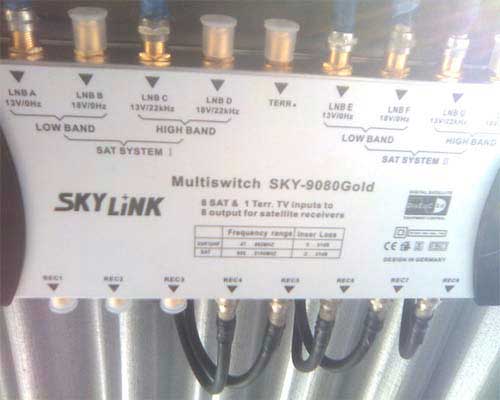 Scheme for connecting a multiswitch for a satellite antenna [/ caption] A regular air-type antenna should be connected to the connector with “Terr” engraving, or a signal from a video camera externally. To connect a radial multiswitch, the following circuit is used:
Scheme for connecting a multiswitch for a satellite antenna [/ caption] A regular air-type antenna should be connected to the connector with “Terr” engraving, or a signal from a video camera externally. To connect a radial multiswitch, the following circuit is used: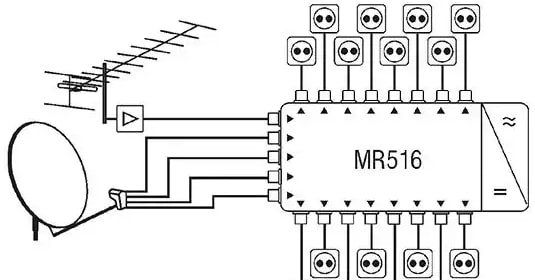 The figure shows the MR516 model. Based on the name in the formula, the scheme will be 5 * 16. There will be 5 inputs (1 for terrestrial TV), and 4 for satellite transmission. 4 connections, because each polarization has two ranges.
The figure shows the MR516 model. Based on the name in the formula, the scheme will be 5 * 16. There will be 5 inputs (1 for terrestrial TV), and 4 for satellite transmission. 4 connections, because each polarization has two ranges.
Advice! It is recommended to use the frequency 11700 MHz as the boundary of the identifier of the lower and upper bands. This indicator is a kind of divisor.
After the terrestrial antenna, a TV range amplifier is installed. Often, TV support in multiswitches is performed passively, without any amplification. This is due to differences in the reception of the terrestrial signal, the misuse of which will lead to confusion. The figure below shows a graph of connecting the device to two converters from different antennas and to one over-the-air one: 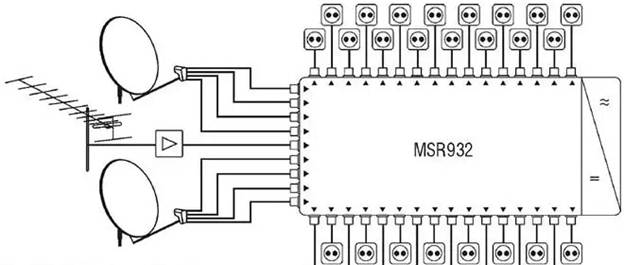 The figure above shows how a quad- converter
The figure above shows how a quad- converter
comes out of each dish. In the end, there were 8 satellite inputs, 32 outputs and a standard 1 for a terrestrial signal with amplification at the TV input. A cascading multiswitch is connected as follows: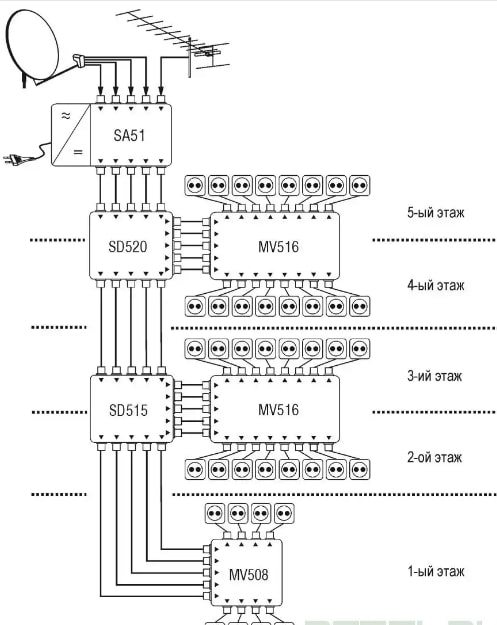 Model MV516 features a die-cast metal housing that protects the structure from external electromagnetic interference. There are both passive and active paths for terrestrial TV. How to connect 10 TVs to one antenna using a multiswitch: https://youtu.be/BjFxA5Fv_IM
Model MV516 features a die-cast metal housing that protects the structure from external electromagnetic interference. There are both passive and active paths for terrestrial TV. How to connect 10 TVs to one antenna using a multiswitch: https://youtu.be/BjFxA5Fv_IM
Frequently asked questions and their solutions
The first frequently asked question is: “What type of signal is multiswitch capable of transmitting?” Answer: in addition to the obvious satellite conversion, the multiswitch also powers the terrestrial amplifiers through the TV input.
The second question is, “Why can’t I just use the receiver?” Answer: it is possible, but this option is not suitable for premises in which it is not permissible to install no more than 3 receivers. Do not forget that the signal is split, thereby creating the effect of tied hands.
The third question is: “How can I myself reduce the incoming load to the receiver?”. Answer: For this, it is recommended to purchase a multiswitch, into which a separate power supply is already inserted.
The fourth question: “Is it possible to use a multiswitch, DiSEqC and a diplexer for one satellite system?”Answer: “Modern technologies allow you to do this without any problems.”
Fifth question: “What converter should I take for a European satellite?” Answer: “Universal”.
Sixth question: “I want to connect 2 receivers to one plate. Which receiver is better to buy? ”. Answer: none, you need a converter.
Seventh question: “What is a switch?” Answer: DiSEqC. The main principle of the device and the concept of multiswitch operation is very simple: fewer antennas for more users. And indeed it is. One small fixture can replace a bunch of iron plates and balance the stress of several living quarters. Used to separate the signal.
